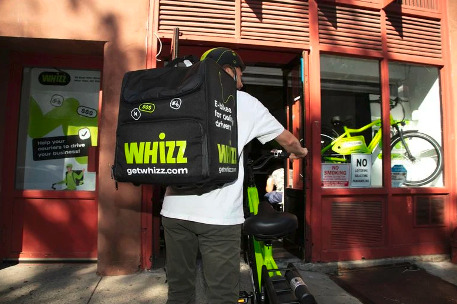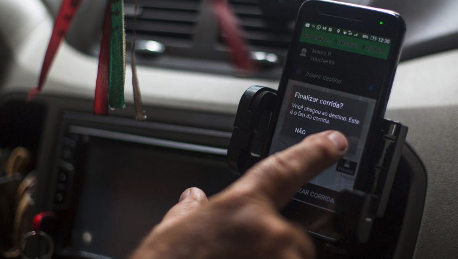Harry is an investor in Whizz, a new e-bike startup that is starting to shake up the delivery business.
Also in the news is an app in Brazil that tells drivers if a ride is worth picking up or not, and it’s making Uber mad.
Listen to RSG 244 on YouTube, Spotify, or Apple. Harry speaks with Justin Spratt of VEI about the compelling vision for the future of teledriving.
E-Bike Startup Whizz Offers A Lifeline To Delivery Workers
Topic Originally Appeared On Crain’s New York
Summary
Orville Feanny, who lives in Brooklyn and works as a DoorDash and Uber Eats delivery driver, has given up on owning his own e-bike. The two he bought were both stolen. He was also paying more than $100 a month for maintenance and repairs, he says, and he couldn’t work when his e-bike was in the shop.
Last year, Feanny started renting an e-bike from Whizz, a startup based in the West Village. The monthly fee includes unlimited maintenance and repairs. And if a repair takes more than 30 minutes, Whizz gives him a loaner.
“It’s more convenient,” he says. “And it’s a good deal. Personally, I earn $200 a day, so the bike is paying for itself in a day or two.”
Whizz was launched at the start of 2022 by co-founders Ksenia Proka and Alex Mironov. The married couple had founded a similar e-bike rental company in Moscow and sold it to a Russian hedge fund before moving to New York. They were soon joined by co-founder Mike Peregudov, who had launched and sold the largest meal kit company in Russia.
“I met them for dinner and decided to invest,” says Peregudov. “I first wrote a small check, but I quickly realized that it’s a really cool opportunity, and I somehow got full-time involved as CEO.”
A fourth co-founder, Chief Technology Officer Artem Serbovka, lives in Dubai.

My Take
Whizz is simply making it more affordable for delivery workers to do their jobs and keep more of their hard-earned money. E-bikes are expensive, and that’s not even including charging and maintenance. It’s great to see an affordable option for city dwellers who want to do delivery gig work.
Granted, it works best in cities like New York, where there’s a strong e-bike presence already. Not all cities are as bikeable as NYC, but to have an affordable e-bike option for delivery drivers is huge.
It’ll be exciting to see where else this will skyrocket to. Best of luck to Whizz!
Uber Hates This App That Tells Drivers Whether It’s Worth Picking You Up
Topic Originally Appeared On Rest of World
Summary
StopClub shows drivers how far they’ll have to drive for a certain fare on a ride-hailing platform. The app allows drivers to increase their earnings by rejecting unprofitable rides.
Uber lost an injunction against StopClub after failing to demonstrate that its features violated industrial property rights or caused unfair competition.

In March 2023, Luisa Pereira made a slight tweak to the way she accepted trips as a ride-hailing driver in São Paulo and almost immediately saw a significant rise in her weekly earnings.
“It’s almost like the cost of a gas tank every week — around 200 reais ($41),” she told Rest of World.
All Pereira had done was download a free app called StopClub onto her phone.
My Take
We’ve had similar apps in the U.S. over the years that will help you filter down to the rides you’d actually like to accept based on earnings, rider ratings, and more. Uber and Lyft did everything they could to prevent these apps from functioning here.
Did Brazil crack a code that we haven’t been able to get around here yet? It sounds like this is a different tactic. Instead of filtering out rides you don’t want based on criteria provided by the app, the app simply breaks down what your earnings would be at a glance so you can make a better informed quick decision.
These rideshare apps don’t give a whole lot of time or information to make the decision to accept a ride or not. Having it laid out before you in a comprehensive way is game-changing.
As the app proved in court, they are not collecting or holding any personal information, but instead, it is reading and interpreting the information provided by the rideshare company and spitting it out in an easier format for drivers to make the snap decision to accept or reject ride requests. Brilliant.
A Millennial Who Quit Teaching To Be A Full-Time Uber And Lyft Driver Has Made $36,000 So Far This Year — But Thinks It’s Better As A Part-Time Gig
Topic Originally Appeared On Business Insider
Summary
When the 2022 school year came to a close, Aaron Lavender, then an elementary-school teacher in Colorado, decided that he needed a break from a job that was often “unbelievably stressful.”
He’d been driving part time for Uber and Lyft since 2021, but last summer, he decided to go full time — driving at least 40 hours a week.
Lavender said he’s enjoyed the break from the classroom and that after working with kids for most of his career, it was fun meeting adult passengers from across the globe. He was even able to attend Burning Man this year, a “long-term dream” he said wasn’t possible when he was a teacher.
My Take
There was a time when Uber was suitable as a full-time job, but that was a while ago, and now the pay is not anywhere near it was at its inception. The bonuses and guarantees are a fraction of what they used to be.
It’s a great part-time option and can be extremely lucrative if you live in a busy market, are able to work the busiest times and have the ability to adapt to constant changes in the market and rideshare platforms themselves. You also have to have the “right” personality for this gig.
Several people aren’t able to cut it simply because they don’t have that thing that makes them great rideshare drivers who connect with their riders and are able to earn consistent tips to help bolster the pay from the apps themselves.
Rates have been cut over the years, but they haven’t been increased for drivers. What we have seen and heard a lot of gripes about, however, is the increase in costs for riders. The money is likely going straight to the pockets of the companies and the cities that charge extra fees for the services to be available in their market. It is not going to the drivers.
Read How Much Should Uber Pay Its Drivers?
GPS Leads DoorDash Driver Delivering Dunkin To A Massachusetts Swamp, Police Say
Topic Originally Appeared On USA Today
Summary
A DoorDash driver was charged with negligent operation of a motor vehicle after they drove their car into a body of water in Middleton, a town 30 miles north of Boston, Massachusetts, while following their GPS, authorities have said.
Middleton Police, in a statement, said that they received a call for a car in a body of water in the woods last Friday morning. The driver was able to exit the vehicle and walk out of the woods to a home nearby, said the police.
As officers arrived on the scene, they found the driver “panicked, claiming that their vehicle was underwater.”
My Take
I know I shouldn’t laugh at this, but I can’t help but laugh at this. It kind of reminds me of an episode of The Office where Michael is following the GPS and is like it says turn here, so I’m going to turn here even though it was clearly driving him right into a lake and meant the turn in the road that was about 50 feet further up.
There are certain times when you need to do this thing where you use logic and your own reasoning over the commands of your GPS. How can you turn your vehicle, literally off road, and continue until your vehicle is submerged in water? I don’t get it.
It makes sense that he was charged. That is just ridiculous.
Instacart Shares Fall Further Below IPO Price
Topic Originally Appeared On Reuters
Summary
Instacart’s (CART.O) stock dropped 4% on Wednesday, marking a fresh low a day after it closed for the first time under the price in the grocery delivery platform’s high-profile initial public offering.
Shares of Instacart, formally called Maplebear, last traded at $28.71 compared to the $30 price set in its IPO on Sept. 18.
Retail investors bought almost $12 million worth of Instacart shares in the company’s first trading session, and net purchases have steadily declined since then, amounting on Wednesday to about $100,000, according to Vanda Research, which tracks retail trades.
My Take
This doesn’t sound good. Granted, I don’t know much about the stock market, but I’m pretty sure it’s not a good thing when the cost per share dips under the IPO amount within the first couple of weeks.
Not looking great there, Instacart. Time to turn things around.
RSG in the News This Week
Read more trending topics in the news this week:




